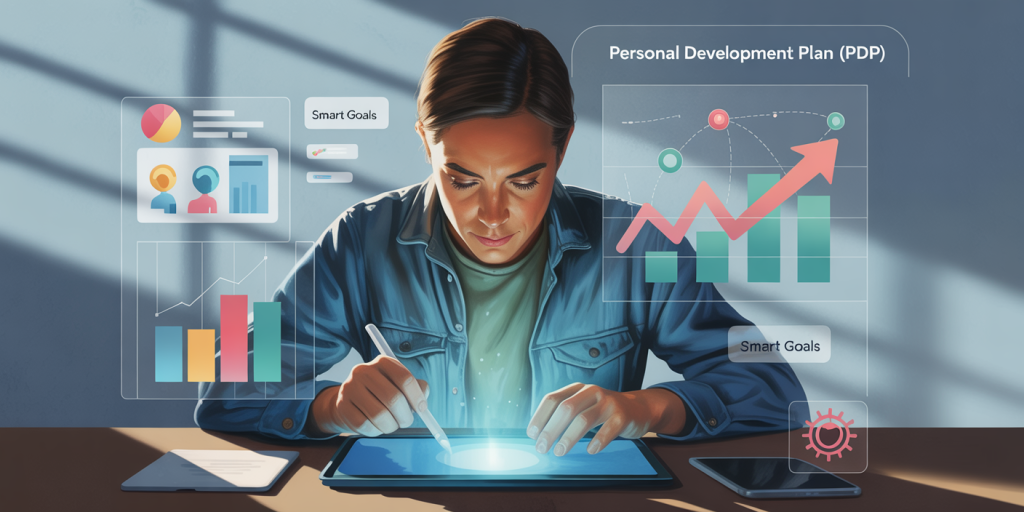In today’s fast-paced and competitive job market, having a clear path for career growth is essential. A Personal Development Plan (PDP) helps individuals identify their professional goals, skills gaps, and strategies for achievement. By creating a well-structured PDP, employees and job seekers can boost their employability, increase job satisfaction, and adapt to evolving industry demands. According to a LinkedIn Workplace Learning Report (2023), 94% of employees would stay at a company longer if it invested in their career development, demonstrating the increasing importance of personal growth initiatives.

This article explores practical steps to develop an effective PDP, real-world case studies, and comparative insights to guide you toward meaningful career advancement.
Understanding the Purpose and Benefits of a Personal Development Plan
A Personal Development Plan lays out a systematic approach to improving your skills, knowledge, and experience to advance your career. Unlike generalized lifelong learning, a PDP is tailored specifically to your career ambitions and current workplace environment. It prioritizes goals and focuses on concrete actions, timelines, and resources.

Multiple benefits arise from crafting a PDP. Firstly, self-awareness increases by encouraging reflection on your strengths and development areas, providing clarity on what to focus on. Secondly, having measurable goals can enhance motivation and professional confidence. For example, a Deloitte survey (2022) found that professionals with documented career plans reported 30% higher engagement at work than those without.
One practical case is Sarah, a mid-level marketing manager aiming to transition into digital marketing leadership. Through a PDP, she mapped out the necessary certifications in digital analytics, sought mentoring, and committed to quarterly progress reviews. Within 18 months, Sarah was promoted to a digital marketing director role, attributing her success to disciplined planning and ongoing skill acquisition.
Key Components of an Effective Personal Development Plan
Creating a PDP that delivers tangible results involves several core elements: goal setting, skills assessment, planned development activities, and monitoring progress.
Goal Setting: SMART Criteria
Goals must be Specific, Measurable, Achievable, Relevant, and Time-bound (SMART). For example, instead of “improve communication skills,” a SMART goal would be “complete a professional public speaking course by December 2024 to improve presentation skills for client meetings.”
Setting detailed goals aligns your efforts with clear outcomes and avoids vague ambitions. In addition, breaking down long-term objectives into short-term milestones keeps progress manageable and prevents overwhelm.
Conducting a Skills Gap Analysis
Assessing your current skills against the requirements of your target role is crucial. This involves reviewing job descriptions, industry standards, or leadership competencies to determine where gaps exist. Tools like competency frameworks or 360-degree feedback can provide valuable insights.
For instance, John, an IT specialist, found through a 360-review that while his technical expertise was strong, his leadership and project management skills needed improvement before he could move into a managerial role. This discovery focused his development activities on acquiring certifications like PMP and leadership training.
Planning Development Activities
Development activities can take many forms: formal training programs, online courses, workshops, mentoring, job shadowing, or participation in professional networks.
An example of structured planning might involve dedicating 4 hours per week to online courses on data analytics, voluntarily leading small projects at work for hands-on experience, and attending industry conferences twice a year.
Monitoring and Reviewing Progress
Regular reviews ensure the PDP remains dynamic and responsive to changing circumstances. It is advisable to schedule quarterly reviews to assess achievements, challenges, and adjust goals when necessary.
A useful approach is journaling progress and feedback received, which fosters accountability and continuous improvement.
Practical Tools and Templates for Developing Your PDP
Various tools and templates are available, from Excel sheets to specialized software, to help organize and optimize your PDP.
| Tool Type | Features | Best Suited For | Cost |
|---|---|---|---|
| Excel or Google Sheets | Customizable goal tracking | Beginners or budget-conscious | Free |
| Trello or Asana | Visual boards, task deadlines, collaboration | Individuals and teams | Free to moderate |
| Dedicated Apps (e.g., CoachAccountable, MyPDP) | Comprehensive development tracking, resources, analytics | Professionals seeking structured guidance | Subscription-based |
Using digital tools enables dynamic updates, reminders, and integration with calendars, enhancing plan adherence. For example, Anne, a sales executive, uses Trello to break her yearly goals into monthly tasks, which she updates in real-time and shares with her mentor.

Overcoming Common Challenges in Personal Development Planning
Despite its benefits, many professionals struggle with maintaining their PDP due to lack of time, motivation, or clarity.
Time Management Difficulties
Balancing daily work demands with development activities can be daunting. Prioritizing development like any business project, by allocating fixed weekly time slots, is essential. Consider microlearning approaches, such as 15-minute daily skill modules, which reduce the burden and sustain momentum.
Staying Motivated and Accountable
Without accountability, enthusiasm can wane. Partnering with a mentor, coach, or peer group to review progress and provide encouragement can strengthen persistence. Sharing your plan with supervisors can also garner support and resources.
Changing Career Goals
Evolving interests or market shifts may necessitate revising your PDP. Remaining flexible allows incorporation of new objectives without discouragement. For example, Rachel initially focused on healthcare IT but pivoted to health data analytics when recognizing greater market demand, adjusting her PDP accordingly.
Measuring the Impact of Your Personal Development Plan
Evaluating the effectiveness of your PDP is vital to validate efforts and inform future planning. Metrics can include: Achievement of specific certification or skill benchmarks Promotions or role changes achieved Enhanced performance review outcomes Increased earning potential
Data from the CIPD’s Learning and Development Annual Survey (2023) indicates that 68% of organizations saw a direct correlation between structured PDP implementation and employee performance upgrades.
A comparative example highlights two employees in a software company: Employee A followed a structured PDP and earned a senior developer role in 12 months, with a 15% salary increase; Employee B lacked a formal plan and remained in the same role.
| Indicator | Employee A (With PDP) | Employee B (Without PDP) |
|---|---|---|
| Role Advancement Time | 12 months | 24 months+ |
| Salary Increase | 15% | 5% |
| Performance Ratings | Consistently exceeds expectations | Meets expectations |
| Job Satisfaction (Survey) | High | Moderate |
These clear, outcome-based facts underscore the tangible advantages of personal development planning.
Future Perspectives: Adapting Your Career Plan for Emerging Trends
As the nature of work continues to transform with automation, AI, and globalization, your personal development plan must evolve to address emerging skill demands and career pathways.
For example, the World Economic Forum’s Future of Jobs Report (2023) identifies critical skills like complex problem-solving, creativity, and emotional intelligence as increasingly important. Incorporating these into your PDP by seeking interdisciplinary learning or soft skills training will future-proof your career.
Furthermore, embracing lifelong learning technologies such as AI-powered personalized learning platforms can optimize your development journey. Keeping your plan adaptable ensures you capture opportunities in new industries or roles as they arise.
Consider Sophie, a finance professional who integrated sustainability and ESG (Environmental, Social, Governance) training into her PDP after market shifts highlighted the importance of responsible investing. This forward-thinking approach enabled her to lead innovative projects and secure executive leadership roles.
In conclusion, a well-crafted Personal Development Plan is a cornerstone of sustained career success. By setting clear goals, assessing your skills realistically, planning actionable development steps, and regularly reviewing progress, you can navigate your career trajectory with confidence. Staying adaptable and aligned with future trends will empower you to seize new opportunities and remain competitive in a rapidly changing professional landscape.

Deixe um comentário